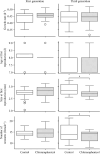Daphnia stress response to environmental concentrations of chloramphenicol-multi-omics approach
- PMID: 39317899
- PMCID: PMC11513740
- DOI: 10.1007/s11356-024-35045-4
Daphnia stress response to environmental concentrations of chloramphenicol-multi-omics approach
Abstract
Commonly used medicines, when discarded or improperly disposed of, are known to contaminate freshwater ecosystems. Pharmaceuticals can be toxic and mutagenic, and can modify freshwater organisms, even at environmentally relevant concentrations. Chloramphenicol (CAP) is an antibiotic banned in Europe. However, it is still found in surface waters around the world. The aim of this study was to evaluate the impact of chloramphenicol contamination in freshwater on the model organism Daphnia magna. Specific life history parameters, proteome, and host-associated microbiome of four D. magna clones were analyzed during a three-generation exposure to CAP at environmental concentrations (32 ng L-1). In the first generation, no statistically significant CAP effect at the individual level was detected. After three generations, exposed animals were smaller at first reproduction and on average produced fewer offspring. The differences in D. magna's life history after CAP treatment were in accordance with proteome changes. D. magna's response to CAP presence indicates the high stress that the tested organisms are under, e.g., male production, upregulation of ubiquitin-conjugating enzyme E2 and calcium-binding protein, and downregulation of glutathione transferase. The CAP-exposed D. magna proteome profile confirms that CAP, being reactive oxygen species (ROS)-inducing compounds, contributes to structural changes in mitochondria. Microbiome analysis showed a significant difference in the Shannon index between control and CAP-exposed animals, the latter having a more diverse microbiome. Multilevel analyses, together with long exposure in the laboratory imitating conditions in a polluted environment, allow us to obtain a more complete picture of the impact of CAP on D. magna.
Keywords: Antibiotics; Life history; Microbiome; Proteome.
© 2024. The Author(s).
Conflict of interest statement
The authors declare no competing interests.
Figures




Similar articles
-
Contamination of aquatic environment with anticancer reagents influences Daphnia magna - Ecotoxicogenomics approach.Ecotoxicol Environ Saf. 2023 Jan 1;249:114372. doi: 10.1016/j.ecoenv.2022.114372. Epub 2022 Dec 9. Ecotoxicol Environ Saf. 2023. PMID: 36508828
-
Long-Term Toxicity of Gadolinium to the Freshwater Crustacean Daphnia magna.Bull Environ Contam Toxicol. 2022 May;108(5):848-853. doi: 10.1007/s00128-021-03388-0. Epub 2021 Oct 12. Bull Environ Contam Toxicol. 2022. PMID: 34636960
-
How cyclophosphamide at environmentally relevant concentration influences Daphnia magna life history and its proteome.PLoS One. 2018 Apr 5;13(4):e0195366. doi: 10.1371/journal.pone.0195366. eCollection 2018. PLoS One. 2018. PMID: 29621334 Free PMC article.
-
Evaluation of the subtle effects and oxidative stress response of chloramphenicol, thiamphenicol, and florfenicol in Daphnia magna.Environ Toxicol Chem. 2019 Mar;38(3):575-584. doi: 10.1002/etc.4344. Epub 2019 Feb 18. Environ Toxicol Chem. 2019. PMID: 30569581
-
Effects of natural nanoparticles on the acute toxicity, chronic effect, and oxidative stress response of phenicol antibiotics in Daphnia magna.Environ Sci Pollut Res Int. 2023 Feb;30(8):21535-21547. doi: 10.1007/s11356-022-23695-1. Epub 2022 Oct 22. Environ Sci Pollut Res Int. 2023. PMID: 36272006
Cited by
-
What Is the Potential of Daphnia (Water Flea) Predation as a Means of Biological Suppression of Prymnesium parvum (Golden Algae) Blooms in Ecologically Relevant Conditions?Plants (Basel). 2025 Jun 11;14(12):1796. doi: 10.3390/plants14121796. Plants (Basel). 2025. PMID: 40573784 Free PMC article.
References
-
- Benzie IFF (1996) Lipid peroxidation: a review of causes, consequences, measurement and dietary influences. Int J Food Sci Nutr 47(3):233–261 - PubMed
MeSH terms
Substances
Grants and funding
LinkOut - more resources
Full Text Sources
Miscellaneous

